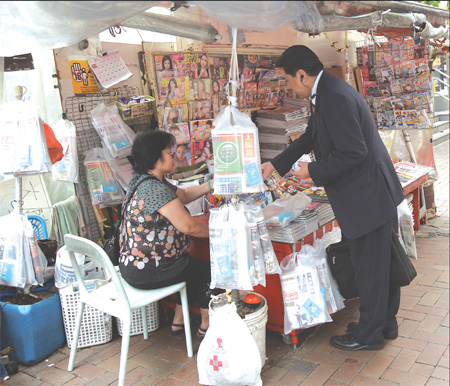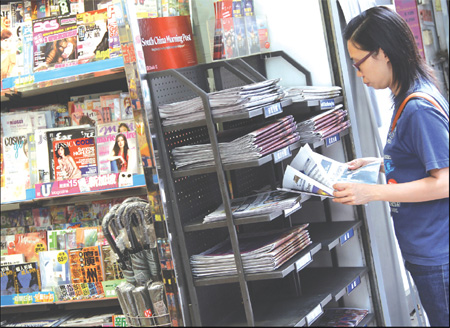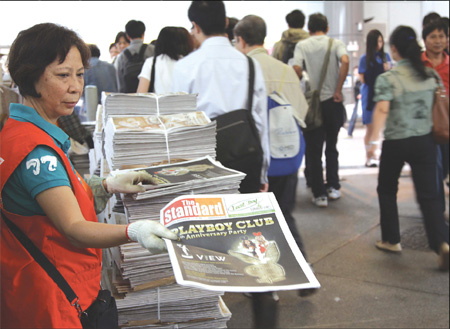Last stand
Updated: 2010-06-08 07:36
By Timothy Chui(HK Edition)
|
|||||||||

|
Top: A man buys a newspaper from a newsstand at Tai Po Market Station. Above: A woman hands out The Standard, the city's free English newspaper, at Tai Po Market Station. Below: A woman picks up a newspaper at a 7-Eleven convenience store at Tsim Sha Tsui. Edmond Tang / China Daily |

The newsstand, once an institution on Hong Kong's streets is slowly disappearing. With competition from chain stores, news online, declining newspaper sales, free newspapers and government regulation, the once popular newsstand will soon vanish from the city's streets. Timothy Chui reports.
Once ubiquitous heralds of an era past, they offered a snap shot of the world along with a roll of gum, diversions of general interest or something a bit seedy and as always, shelter from the rain under their sponsored awnings.
The news stand stood sentinel on the street side as part of a morning ritual where coin was exchanged for a grip of paper, tobacco and a quick jibe with a familiar face before the morning or afternoon commute.
But in an era where the city's Octopus Card that has increasingly replaced coin and ink-free content is just a click away, these open-air precursors to the convenience store are now ossified and have entered a state of decline.
"The business has problems and my kids don't want any part of it. How do you make money when you're being squeezed from every side?" ponders Tang Kam-cheong, an elderly newsstand owner, as he gingerly unboarded his stand and arranged his wares at the corner of Des Voeux Road West and Queen Street.
Situated on the tramline, Tang's stand is on the way for thousands of commuters catching a bus or plodding the pavement en route to the subway but the number of people stopping by for a quick coin swap has dropped off in the two decades he's spent at his post alternating with his wife, unable to get his kids to put in the hours. Luckily, he is situated outside the dim sum restaurant Lin Heung Kui whose daily clientele of elderly couples, late risers and single men still create a steady trickle of sales for Chinese language dailies and racing forms.
But Tang's stand won't last much longer because he cannot transfer his license.
The government's decision to stop issuing licenses in the 1980s has blocked fresh blood from entering the marketplace and while existing licenses can be transferred to family members, newsstands without heirs apparently face a crisis of manpower and the freeze promises to bring the stands to an eventual end.
Calling newspaper hawking a sunset industry in Hong Kong, former vice-chair of the Hong Kong Newspaper Society and professional consultant at the City University's School of Journalism David Wong Chun-tung said their disappearance was inevitable under government guidelines which he said were meant to free up pedestrian space.
"Over the few years we will see their numbers continue to drop from around 2,200 now to around 1,500. They made good money over the past two decades but it may be time to get out because there are bigger problems on the horizon, such as a new generation which will have everything online, news, magazines and the like," he said.
Hawkers are also coming up against an all-pervasive competitor, the chain convenience store which vendors say will accelerate the gradual extinction of their trade.
Chief Executive Officer of Ming Pao Keith Kam said news vendors which used to be present on nearly every street of the city are retreating in the face of stiff competition from chain stores whose direct purchasing of newspapers with economies of scale gives them an unassailable advantage over the mom and pop newsstands.
"The number of newsvendors has plummeted since the proliferation of chain stores in the 1980s, and the only ones still hanging on are those operators who have good locations with heavy foot traffic. The new towns in the New Territories aren't as congested as areas like Kowloon and Hong Kong Island, so ultimately it's easier for people to pick up a paper while they do their grocery shopping or go to a place where they can also recharge their Octopus cards," he said.
Armed with bigger profit margins and offering a better one-stop shop experience, every convenience store that has opened has led to two to three news vendors closing their stands for good, Kam said.
Setting up shop in 1981 and opening their 711th store on July 11, 2006, 7-Eleven's presence in the city is numbered at nearly 1,000 shops while its competitor Circle K has roughly 400 in the Pearl River Delta region, representing a formidable force facing off with small-time independent operators.
Tectonic shifts in their supplier's industry has also filtered down to the streets with newspapers dropping prices, narrowing hawker margins, and offering on-line versions effectively taking newsstands out of the loop.
Advertisers moving their dollars from print to online has led to total average newspaper revenues declining 10 percent since 2003, according to Price Waterhouse Coopers' Outlook for Newspaper Publishing in the Digital Age 2009 report.
While the growth of online content brought circulations down, some newspapers are retooling to tighten overheads and attempting to recapture readership; others are shifting their business models and have entered the free-paper market.
Hong Kong's The Standard has managed to weather the global economic downturn without culling staff by moving its revenue stream exclusively to advertising when it went free in September 2007.
Editor-in-chief Ivan Tong said the decision to go free was timely given the Hong Kong Stock Exchange's relaxation of notice rules for listed companies which would hit the paper's bread and butter revenue stream.
Taking a page from the paper's parent company's wildly successful Headline Daily, The Standard revamped itself into a very readable, free, daily dose of the day's news. Capitalizing on the expatriate population and the city's large English as a Second Language reader base, Tong said, "We originally targeted roughly 120,000 copies a day but within weeks demand had surged to 200,000 a day. Prior to going free The Standard was averaging around 40,000 to 50,000 copies a day."
The proliferation of free newspapers in the city led to bad blood with some vendors while the Hong Kong Newspaper Hawker alleged free papers such as Headline Daily led to drops of 10 to 20 percent in news vendor transactions.
With the government, corporations and free content squeezing business from three sides, the future of the news vendor business looks bleak to Rebecca Chan who works the Ngan Kee Newspaper stand with her brother Chan Siu-lam just outside the Wan Chai MTR station at O'Brian Road and Hennessey Road.
Working their stall for nearly a decade, Chan said business wasn't likely ever to return to pre-Internet levels, saying business had dropped 50 percent since people could get their news for free online.
The "news" in "news vendor" was also becoming increasing irrelevant, she said.
"More than half of our business is selling magazines and manga. I don't see a long term future for us or the business because there aren't new licenses and there isn't any incentive for the next generation to carry on," she said.
Unable to save enough for her kids' education, she said she wouldn't want her kids to follow her trade, happy that her eldest recently earned a degree in accounting.
"I wouldn't wish this on my children. We work 12 to 15 hours a day, when it's hot, it is very hot; when it's cold, it's really cold and when it's wet, your merchandise gets soaked. More and more of our colleagues are dropping out of the business and there isn't much of a future to look forward to."
(HK Edition 06/08/2010 page2)
